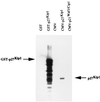High level expression of p27(kip1) and cyclin D1 in some human breast cancer cells: inverse correlation between the expression of p27(kip1) and degree of malignancy in human breast and colorectal cancers
- PMID: 9177226
- PMCID: PMC21058
- DOI: 10.1073/pnas.94.12.6380
High level expression of p27(kip1) and cyclin D1 in some human breast cancer cells: inverse correlation between the expression of p27(kip1) and degree of malignancy in human breast and colorectal cancers
Abstract
The expression of cyclin-dependent kinase inhibitor p27(kip1) in human tumors and normal tissues was investigated using a panel of novel anti-p27(kip1) mAbs. An inverse correlation between expression of p27(kip1) and cell proliferation was generally observed after analyzing its expression in 25 different normal human tissues. In some highly proliferative human breast cancer cells, however, high level p27(kip1) expression was seen, indicating the existence of a mechanism by which some growing tumor cells may tolerate this inhibitor of cell cycle progression. Detailed studies demonstrated a correlation between the high level expression of p27(kip1) and cyclin D1 in human breast cancer cells. There was also an inverse correlation between the expression of p27(kip1) and the degree of tumor malignancy in human breast and colorectal cancers, indicating that p27(kip1) may be a useful prognostic marker in these cancers.
Figures





References
-
- Draetta G F. Curr. Opin Cell Biol. 1994;6:842–846. - PubMed
-
- Elledge S J, Harper J W. Curr Opin Cell Biol. 1994;6:847–852. - PubMed
-
- Polyak K, Lee M, Erdjument-Bromaga H, Koff A, Roberts J M, Tempst P, Massague J. Cell. 1994;78:59–66. - PubMed
-
- Polyak K, Kato J, Solomon M J, Sherr C J, Massague J, Roberts J M, Koff A. Genes Dev. 1994;8:9–22. - PubMed
-
- Reynisdottir I, Polyak K, Iavarone A, Massague J. Genes Dev. 1995;9:1831–1845. - PubMed
Publication types
MeSH terms
Substances
LinkOut - more resources
Full Text Sources
Other Literature Sources
Medical
Research Materials
Miscellaneous

